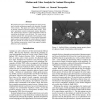10 search results - page 1 / 2 » Homeostatic image perception: An artificial system |
CVIU
2006
13 years 4 months ago
2006
This paper describes how a visual system can automatically define features of interest from the observation of a large enough number of natural images. The principle complements t...
CORR
2004
Springer
13 years 4 months ago
2004
Springer
Some recent studies have pointed that , the self-organization of neurons into brain-like structures, and the self-organization of ants into a swarm are similar in many respects. I...
AAAI
1996
13 years 6 months ago
1996
We propose novel gaze control algorithms for active perception in mobile autonomous agents with directable, foveated vision sensors. Our agents are realistic artificial animals, o...
JEI
2008
13 years 3 months ago
2008
Electronic visual prostheses, or "bionic eyes," are likely to provide some coarse visual sensations to blind patients who have these systems implanted. The quality of art...
CIVR
2007
Springer
13 years 11 months ago
2007
Springer
In this paper, we develop a system to classify the outputs of image segmentation algorithms as perceptually relevant or perceptually irrelevant with respect to human perception. T...

